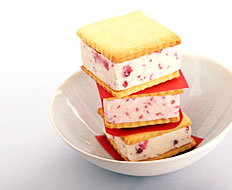Ever gotten thoroughly sick of eating ice cream? Ever cringed at the idea of taking yet another lap of a French vanilla cone flecked with chocolate sprinkles, or recoiled at the thought of having to choke down a second scoop of triple-chocolate brownie fudge ripple with almonds, marshmallow, and white-chocolate chunks?
Of course you haven’t. With the possible exception of people recuperating from particularly painful tonsillectomies, no one has ever come down with a case of ice cream fatigue. I’ve heard people say they could survive on nothing else; I’ve never heard anyone say he couldn’t stand the stuff.
And here’s the irony: Even though we Americans continually identify dull vanilla as our favorite ice-cream flavor, the amount of creativity unfolding in the frozen dessert category is astounding.
I’m not just talking about some of the more unusual ice cream flavors we’re seeing at shops such as Humphry Slocombe in San Francisco’s South of Market neighborhood—think boccalone prosciutto, Guinness gingerbread, kumquat poppy seed, salted licorice, and sweet corn blackberry—but instead even stranger innovations. Consider the novel ice pops with Latin-American flavor profiles, esoteric sorbets, delectable ice creams made with alternative milks, and the revival of soda fountain favorites like malts and egg creams (the latter of which, incidentally, contains neither eggs nor cream).
Perhaps the most novel frozen dessert trend in recent years is something we’re seeing more of in the fine-dining world: freezing ice cream to order at diners’ tablesides using liquid nitrogen. A few years ago, YouTube showcased a viral video of a waiter at England’s Three-Michelin-Star Fat Duck restaurant preparing bacon-and-egg ice cream with French toast as diners looked on in astonishment. More about this creative use of cryogenics in a moment.
Last year, we at the Center for Culinary Development surveyed the “sweetscape” and published a hefty Confections & Desserts Trend Mapping Report in partnership with Packaged Facts. The report identified four distinct drivers of Americans’ dessert cravings in the early 2010s: nostalgia, indulgence, the desire for “flavor adventure,” and artisan appeal.
Nostalgia is driving restaurateurs in particular to revisit once-classic treats such as baked Alaska, and to concoct gourmet versions of such childhood favorites as the humble whoopie pie. Dessert is an indulgence by nature, but some crafty pastry chefs, chocolatiers, and confectioners are going to great lengths to overload our pleasure centers by adding various liqueurs to sweets and baked goods.
The desire for more exotic and adventurous flavor profiles is exemplified by Generation Y’s embrace of the left-of-center ice cream flavors noted above. Artisan appeal, on the other hand, is evident in the growing number of handmade candy shops, microbatch chocolate makers, and French macaroon shops popping up in hip urban neighborhoods.
So imagine if you will, a somewhat futuristic but quick-serve-ready idea that neatly incorporates all four key drivers of today’s prevailing dessert trends. Imagine a treat that serves as a flavorful, exciting indulgence but has quality ingredients that can be customized for virtually endless variety.
Ladies and gentlemen, I give you the Made-to-Order Ice Cream Sandwich, now available at your favorite local quick-serve counter, dining room, or drive thru.
The idea: Allow customers to select their own cookie, cake, or biscuit as a carrier, then let them choose from among made-to-order ice cream flavors. The result: A frozen dessert that’s portable, neat to eat, and terrifically decadent.
If the notion sounds far-fetched, consider that it could be done with very little new equipment and with only a modest degree of operational complexity. We’d begin with an inventory of perhaps six to 12 cookie- and cake-based platforms ranging from oatmeal-raisin cookie to pound cake. There’s even the option to use oversized animal crackers or whoopie pies. The instant ice cream would be fashioned from a single base formula combined with various flavor mixes: rum raisin, chocolate mint, blueberry vanilla, or burnt caramel, for example. Then, using a simple, portable liquid-nitrogen contraption, quick-serve employees could create an ice cream “patty” that could be sandwiched between any of the carriers.
I’d love to claim full credit for the idea, but the fact is that made-to-order ice cream is already a reality at shops such as Chicago’s iCream, and a similar concept is reportedly coming soon to San Francisco’s Hayes Valley in a shop called Smitten.
What’s more, the phenomenon isn’t limited to the nation’s large urban centers. In Knoxville, Tennessee, Chill Custom Creamery is practicing the craft, and the clever manufacturers of the MooBella Ice Creamery machine have automated the process and placed it on college campuses and other locales in the Northeast.
Made-to-order ice cream sandwiches, meanwhile, are already a hit at Cream on Telegraph Avenue in Berkeley, California, where lines of patrons snaked around the block on a Friday night in February (yes, February). And a roving, Los Angeles–based operation called Coolhaus reportedly dispenses similar wares from the confines of a truck whose structural novelty earned a nod from Time magazine in 2009 and this publication in an earlier issue this year.
My guess is that the fresh, made-to-order ice cream concept is likely to gain even greater traction in the not-too-distant future. And if that’s the case, it may be an idea worth quick-serve concepts’ consideration today.












